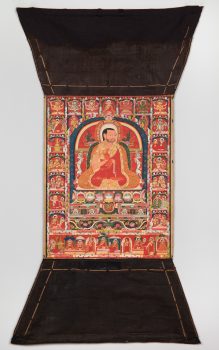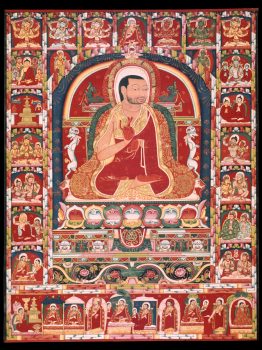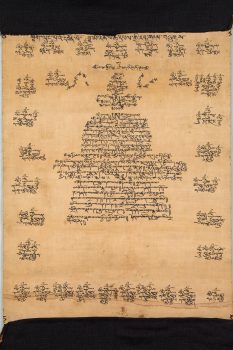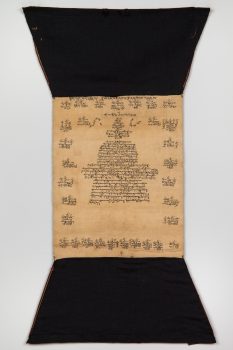Central Tibet
ca. 1270
Also known as vajra position, this posture is associated with meditation.
Central Tibet
ca. 1270




In the center of this early and well-preserved painting is the great teacher Phakmodrupa Dorje Gyalpo (1110–1170). He is flanked by two columns featuring scenes of his previous lives, including his life as a monkey, shown in the scene with a golden stupa near his right shoulder. Phakmodrupa was a charismatic Kagyu mystic, and portraits of him circulated widely during his lifetime. While several later copies of this prototype survive, early versions of this portrait, such as this, are rare.Phakmodrupa’s pupils founded eight later Kagyu Schools of Tibetan Buddhism, including the Taklung Kagyu School, founded by Taklung Thangpa Chenpo (1142–1210), to which this painting belongs. Its main monastic seat, Taklung Monastery (founded in 1185), became an artistic center in its own right with a distinctive East Indian (Sharri) inspired painting style, recognizable by the highly stylized multicolored, narrow (mostly vertical) rock formations used to frame the figures seen in this painting.On the back of the canvas a long text in the shape of a stupa reveres successive Taklung Monastery abbots, the last of which is Sangye Yarjon (1203–1272), allowing the painting to be roughly dated to the late thirteenth century.
Teachings and precepts that offer practical and experiential guidance. In Buddhism instruction is primarily an oral tradition and is often targeted to the specific needs or disposition of a student or disciple.
The passing down of authentic Buddhist teachings from a teacher to a disciple or student, often in the form of a text in a ritualistic context.
The transmission of teachings from one generation to the next, from teacher to student, traced all the way back to the Buddha without interruption. A complete lineage is essential in Tantric Buddhist practices as it makes the blessings of the teaching more powerful.
Himalayan art includes portraits of legendary and historical humans, including accomplished religious teachers (lamas), the Buddha’s original disciples (arhats), and spiritually accomplished tantric masters (mahasiddhas).
Today, Tibetans primarily inhabit the Tibetan Plateau, situated between the Himalayan mountain range and the Indian subcontinent to the west, Chinese cultural regions to the east, and Mongolian cultural regions to the northeast. During the 7th to 9th century, Tibetan rulers expanded their empire across Central Asia, and established Buddhism as the state religion.
Get the latest news and stories from the Rubin, plus occasional information on how to support our work.